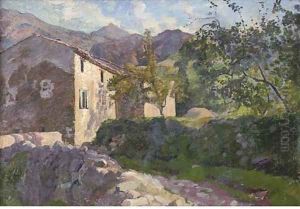Georges-Daniel De Monfried Paintings
Georges-Daniel de Monfreid was a French artist born on March 14, 1856, in New York City to a French family. He spent much of his life in France, where he became associated with the Symbolist movement and was a close friend of many renowned artists, including Paul Gauguin, with whom he maintained a detailed correspondence.
De Monfreid's early life was marked by his family's return to France from the United States, and he grew up in the southern regions of the country. He originally began studying law, but his passion for art prompted him to switch careers. This decision led him to Paris, where he joined artistic circles and began to develop his own style. Although not as widely recognized as some of his contemporaries, de Monfreid's work was respected among his peers for its unique qualities and his exploration of Symbolist themes.
His artistic career evolved through his connections with key figures of the time. De Monfreid was deeply influenced by Gauguin, both personally and artistically, and this is evident in his use of bold colors and a style that sometimes echoed the Post-Impressionist tendencies of his friend. He painted a variety of subjects, from landscapes and seascapes to figure paintings and still lifes, often with a mystical or exotic undertone. De Monfreid's works were exhibited at various Salons and galleries, contributing to the vibrant art scene of late 19th and early 20th century France.
In addition to his painting, de Monfreid was an art collector and a writer. He amassed a collection of African art, which was quite progressive at the time, and his writings included memoirs that provide valuable insights into the lives and practices of the artists within his circle. These texts are particularly important for understanding the dynamics of the Symbolist movement and the Post-Impressionist period in France.
Georges-Daniel de Monfreid passed away on November 26, 1929, in Corneilla-de-Conflent, France. Although his name may not be as familiar as some of his contemporaries, his contributions to the art world and his role in the cultural milieu of his time remain significant. His legacy is preserved in the letters he exchanged with Gauguin, his writings, and the artworks that continue to be displayed in galleries and museums around the world.
